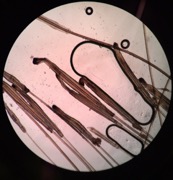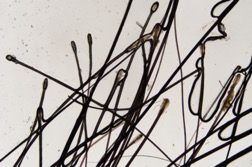| |
|
|
|
|
|
| |
| Hair loss is a very common problem. Patients notice increased hair shedding, with or without visible areas of baldness (alopecia). Hair loss on the scalp can occur in patches, from all over or in pattern. Not only is it disturbing and cosmetically undesirable, it may also signify underlying medical conditions. |
| |
| There are a great number of causes of non-scarring and scarring alopecia. In non-scarring alopecia, the hair follicles are intact and preserved, and the condition of hair loss, if accurately diagnosed and addressed, is reversible. The following are common examples of non-scarring alopecia. |
| |
| Androgenetic alopecia (patterned hair loss) is the most common condition and can occur in both genders. In females, the hair loss is usually resulting from a combination of many factors. The tendency to develop androgenetic alopecia runs in families. To slow down the hair loss, both men and women can consider topical treatment, oral medications, low lever laser therapy (adjunctive measure). |
| |
| Alopecia areata (AA) results from autoimmune attacks at the hair roots, most often resulting in coin-sized patches of baldness on the scalp. Sometimes, the hair regrows by itself. It can also affect the entire scalp and other hair-bearing area. There is also a form of AA which manifests as diffuse hair shedding. Blood tests are needed to check for any underlying conditions. Treatment involves topical medication, injections, light treatment and oral medications if necessary. |
| |
| Telogen effluvium (TE, diffuse hair loss) commonly occurs after severe stress to the body. Physical and emotional stress and certain drugs can cause TE. Acute TE usually stops on its own, while chronic TE can persist if the underlying condition is not corrected. Medications can help correct any contributing conditions and shorten the period of hair loss. |
| |
| In scarring alopecia, our hair follicles are specifically targeted by inflammatory cells, leading to destruction, fibrosis and scar. This adversely affected subsequent hair growth potential. If not diagnosed and treated aggressively early enough, the hair loss is irreversible. In additional to hair loss, patients usually experience scalp symptoms. Apart from primary scarring alopecia, repeated injuries to the scalp and infections of the scalp can also cause similar problems. Treatment include oral medications, topical lotions and intralesional injections. |
| |
| In order to reach the correct diagnosis and address the problem, the dermatologist will do a comprehensive evaluation and clinical examination, photographic and dermoscopic assessment. Sometimes, we need to order blood checks and take skin scraping for examination. Trichogram is needed for accurate diagnosis of diffuse hair shedding because many cases of hair loss, especially in women, are a mixture of AGA and TE or AA. It is the gold standard of hair roots analysis. We need to take hair roots at standardized sites and conditions, and evaluate them individually and thoroughly under microscope. Scalp biopsy is very important for making the diagnosis of scarring alopecia in early phase and help dermatologist decide the treatment. |
| |
| Anagen hair roots (normal) and excess telogen hair roots (can occur in AGA or TE) |
| |
  |
| |
| While awaiting recovery or regrowth of hair, one can consider temporary camouflage of the scalp, appropriate scalp cleansing, hair conditioning and supplements for optimal results. Maintaining good conditions of the scalp is vital to control hair loss. |
| |
| |
|
|
|
| |
|
|
|